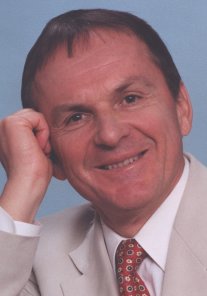
Superconductivity is a set of physical properties observed in certain materials where electrical resistance vanishes and magnetic flux fields are expelled from the material. Any material exhibiting these properties is a superconductor. Unlike an ordinary metallic conductor, whose resistance decreases gradually as its temperature is lowered even down to near absolute zero, a superconductor has a characteristic critical temperature below which the resistance drops abruptly to zero. An electric current through a loop of superconducting wire can persist indefinitely with no power source.

In chemistry, thermodynamics, and many other related fields, phase transitions are the physical processes of transition between a state of a medium, identified by some parameters, and another one, with different values of the parameters. Commonly the term is used to refer to changes among the basic states of matter: solid, liquid, and gas, as well as plasma in rare cases.
The Ising model, named after the physicists Ernst Ising and Wilhelm Lenz, is a mathematical model of ferromagnetism in statistical mechanics. The model consists of discrete variables that represent magnetic dipole moments of atomic "spins" that can be in one of two states. The spins are arranged in a graph, usually a lattice, allowing each spin to interact with its neighbors. Neighboring spins that agree have a lower energy than those that disagree; the system tends to the lowest energy but heat disturbs this tendency, thus creating the possibility of different structural phases. The model allows the identification of phase transitions as a simplified model of reality. The two-dimensional square-lattice Ising model is one of the simplest statistical models to show a phase transition.

In physics, the Wightman axioms, named after Arthur Wightman, are an attempt at a mathematically rigorous formulation of quantum field theory. Arthur Wightman formulated the axioms in the early 1950s, but they were first published only in 1964 after Haag–Ruelle scattering theory affirmed their significance.

Spontaneous symmetry breaking is a spontaneous process of symmetry breaking, by which a physical system in a symmetric state ends up in an asymmetric state. In particular, it can describe systems where the equations of motion or the Lagrangian obey symmetries, but the lowest-energy vacuum solutions do not exhibit that same symmetry. When the system goes to one of those vacuum solutions, the symmetry is broken for perturbations around that vacuum even though the entire Lagrangian retains that symmetry.
A topological soliton or "toron" occurs when two adjoining structures or spaces are in some way "out of phase" with each other in ways that make a seamless transition between them impossible. One of the simplest and most commonplace examples of a topological soliton occurs in old-fashioned coiled telephone handset cords, which are usually coiled clockwise. Years of picking up the handset can end up coiling parts of the cord in the opposite counterclockwise direction, and when this happens there will be a distinctive larger loop that separates the two directions of coiling. This odd looking transition loop, which is neither clockwise nor counterclockwise, is an excellent example of a topological soliton. No matter how complex the context, anything that qualifies as a topological soliton must at some level exhibit this same simple issue of reconciliation seen in the twisted phone cord example.
In physics, Ginzburg–Landau theory, often called Landau–Ginzburg theory, named after Vitaly Ginzburg and Lev Landau, is a mathematical physical theory used to describe superconductivity. In its initial form, it was postulated as a phenomenological model which could describe type-I superconductors without examining their microscopic properties. One GL-type superconductor is the famous YBCO, and generally all Cuprates.
In quantum mechanics, superselection extends the concept of selection rules.
In physics, the terms order and disorder designate the presence or absence of some symmetry or correlation in a many-particle system.
The classical XY model is a lattice model of statistical mechanics. In general, the XY model can be seen as a specialization of Stanley's n-vector model for n = 2.

Hagen Kleinert is professor of theoretical physics at the Free University of Berlin, Germany , Honorary Doctor at the West University of Timișoara, and at the Kyrgyz-Russian Slavic University in Bishkek. He is also Honorary Member of the Russian Academy of Creative Endeavors. For his contributions to particle and solid state physics he was awarded the Max Born Prize 2008 with Medal. His contribution to the memorial volume celebrating the 100th birthday of Lev Davidovich Landau earned him the Majorana Prize 2008 with Medal. He is married to Dr. Annemarie Kleinert since 1974 with whom he has a son Michael Kleinert.
The Berezinskii–Kosterlitz–Thouless transition is a phase transition of the two-dimensional (2-D) XY model in statistical physics. It is a transition from bound vortex-antivortex pairs at low temperatures to unpaired vortices and anti-vortices at some critical temperature. The transition is named for condensed matter physicists Vadim Berezinskii, John M. Kosterlitz and David J. Thouless. BKT transitions can be found in several 2-D systems in condensed matter physics that are approximated by the XY model, including Josephson junction arrays and thin disordered superconducting granular films. More recently, the term has been applied by the 2-D superconductor insulator transition community to the pinning of Cooper pairs in the insulating regime, due to similarities with the original vortex BKT transition.
In statistical mechanics, universality is the observation that there are properties for a large class of systems that are independent of the dynamical details of the system. Systems display universality in a scaling limit, when a large number of interacting parts come together. The modern meaning of the term was introduced by Leo Kadanoff in the 1960s, but a simpler version of the concept was already implicit in the van der Waals equation and in the earlier Landau theory of phase transitions, which did not incorporate scaling correctly.

In physics or mathematics, the scaling limit concerns the behaviour of a lattice model in the limit as the lattice spacing goes to zero. A lattice model which approximates a continuum quantum field theory in the limit as the lattice spacing goes to zero corresponds to finding a second order phase transition of the model. This is the scaling limit of the model. It is often useful to use lattice models to approximate real-world processes, such as Brownian motion. Indeed, according to Donsker's theorem, the discrete random walk would, in the scaling limit, approach the true Brownian motion.

In physics, topological order is a kind of order in the zero-temperature phase of matter. Macroscopically, topological order is defined and described by robust ground state degeneracy and quantized non-Abelian geometric phases of degenerate ground states. Microscopically, topological orders correspond to patterns of long-range quantum entanglement. States with different topological orders cannot change into each other without a phase transition.
In quantum field theory, the 't Hooft loop is a magnetic analogue of the Wilson loop for which spatial loops give rise to thin loops of magnetic flux associated with magnetic vortices. They play the role of a disorder parameter for the Higgs phase in pure gauge theory. Consistency conditions between electric and magnetic charges limit the possible 't Hooft loops that can be used, similarly to the way that the Dirac quantization condition limits the set of allowed magnetic monopoles. They were first introduced by Gerard 't Hooft in 1978 in the context of possible phases that gauge theories admit.
The Coleman–Weinberg model represents quantum electrodynamics of a scalar field in four-dimensions. The Lagrangian for the model is

In physics, a quantum vortex represents a quantized flux circulation of some physical quantity. In most cases, quantum vortices are a type of topological defect exhibited in superfluids and superconductors. The existence of quantum vortices was first predicted by Lars Onsager in 1949 in connection with superfluid helium. Onsager reasoned that quantisation of vorticity is a direct consequence of the existence of a superfluid order parameter as a spatially continuous wavefunction. Onsager also pointed out that quantum vortices describe the circulation of superfluid and conjectured that their excitations are responsible for superfluid phase transitions. These ideas of Onsager were further developed by Richard Feynman in 1955 and in 1957 were applied to describe the magnetic phase diagram of type-II superconductors by Alexei Alexeyevich Abrikosov. In 1935 Fritz London published a very closely related work on magnetic flux quantization in superconductors. London's fluxoid can also be viewed as a quantum vortex.
Macroscopic quantum phenomena are processes showing quantum behavior at the macroscopic scale, rather than at the atomic scale where quantum effects are prevalent. The best-known examples of macroscopic quantum phenomena are superfluidity and superconductivity; other examples include the quantum Hall effect and topological order. Since 2000 there has been extensive experimental work on quantum gases, particularly Bose–Einstein condensates.
The Dicke model is a fundamental model of quantum optics, which describes the interaction between light and matter. In the Dicke model, the light component is described as a single quantum mode, while the matter is described as a set of two-level systems. When the coupling between the light and matter crosses a critical value, the Dicke model shows a mean-field phase transition to a superradiant phase. This transition belongs to the Ising universality class and was realized in cavity quantum electrodynamics experiments. Although the superradiant transition bears some analogy with the lasing instability, these two transitions belong to different universality classes.






